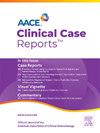Insulinoma: A Novel Presentation of Multiple Endocrine Neoplasia 4
IF 1.2
Q3 Medicine
引用次数: 0
Abstract
Background/Objective
Multiple endocrine neoplasia 4 (MEN4) is a rare syndrome caused by germline mutations in CKDN1B, and it shares clinical manifestations with MEN1, including primary hyperparathyroidism, pituitary adenomas, and pancreatic neuroendocrine tumors (NETs). The prevalence of MEN4 is <1 per million, whereas prevalence of MEN1 is between 1/10 000 and 1/30 000.
Case Report
A 51-year-old woman presented with symptomatic hypoglycemia and incidental hypercalcemia. Workup revealed a fasting plasma glucose level of 41 mg/dL (60-99 mg/dL), proinsulin level of 84.3 pmol/L (≤8.0 pmol/L), insulin level of 24 uIU/mL (3-25 uIU/mL), c-peptide level of 5.2 ng/mL (1.1-4.4 ng/mL), and β-hydroxybutyrate level of 0.34 mmol/L (0.02-0.27 mmol/L), consistent with endogenous hyperinsulinism. Computed tomography scan of the abdomen revealed a 1.5 × 1.1 × 1.0 cm pancreatic head nodule. She underwent pancreaticoduodenectomy, and pathology demonstrated a well-differentiated neuroendocrine tumor with no metastases. She became normoglycemic after surgery, and additional workup revealed primary hyperparathyroidism. Germline testing revealed a variant of unknown significance in CDKN1B (p.R93W).
Discussion
Both MEN1 and MEN4 result from decreased expression of p24 and exhibit similar clinical phenotypes, but there are subtle differences in penetrance and natural history. About 10% of patients with MEN1 have insulinomas, but no insulinomas have been reported in MEN4. primary hyperparathyroidism in MEN4 exhibits a lower risk of recurrence after parathyroidectomy. This case highlights the importance of germline genetic testing when a patient presents with manifestations of MEN1.
Conclusion
To our knowledge, this is the first reported case of insulinoma in MEN4.
胰岛素瘤:多发性内分泌肿瘤的新表现
背景/目的多发性内分泌肿瘤4 (multiple endocrine neoplasia 4, MEN4)是一种罕见的由CKDN1B种系突变引起的综合征,其临床表现与MEN1相似,包括原发性甲状旁腺功能亢进、垂体腺瘤、胰腺神经内分泌肿瘤(NETs)等。MEN4的流行率为百万分之一,而MEN1的流行率为1/ 10,000至1/ 30,000。病例报告:一名51岁女性,以症状性低血糖和偶发高钙血症表现。空腹血糖41 mg/dL (60 ~ 99 mg/dL),胰岛素原水平84.3 pmol/L(≤8.0 pmol/L),胰岛素水平24 uIU/mL (3 ~ 25 uIU/mL), c肽水平5.2 ng/mL (1.1 ~ 4.4 ng/mL), β-羟基丁酸水平0.34 mmol/L (0.02 ~ 0.27 mmol/L),与内源性高胰岛素血症一致。腹部计算机断层扫描显示一个1.5 × 1.1 × 1.0 cm的胰腺头结节。患者行胰十二指肠切除术,病理证实为分化良好的神经内分泌肿瘤,无转移。术后血糖恢复正常,进一步检查发现原发性甲状旁腺功能亢进。种系检测显示CDKN1B (p.R93W)中存在一种未知意义的变异。MEN1和MEN4都是由于p24的表达减少而导致的,它们具有相似的临床表型,但在外显率和自然历史上存在细微差异。大约10%的MEN1患者有胰岛素瘤,但MEN4中没有胰岛素瘤的报道。MEN4原发性甲状旁腺功能亢进症在甲状旁腺切除术后复发的风险较低。本病例强调了当患者出现MEN1表现时,进行种系基因检测的重要性。结论据我们所知,这是MEN4中第一例胰岛素瘤的报道。
本文章由计算机程序翻译,如有差异,请以英文原文为准。
求助全文
约1分钟内获得全文
求助全文
来源期刊

AACE Clinical Case Reports
Medicine-Endocrinology, Diabetes and Metabolism
CiteScore
2.30
自引率
0.00%
发文量
61
审稿时长
55 days
 求助内容:
求助内容: 应助结果提醒方式:
应助结果提醒方式:


